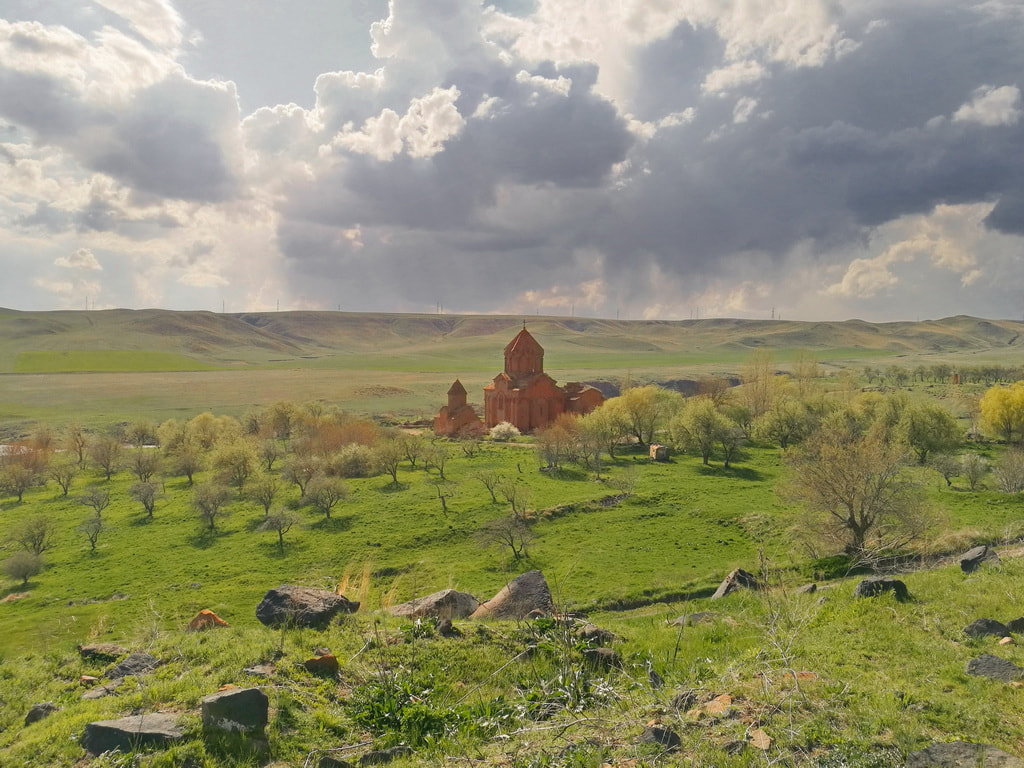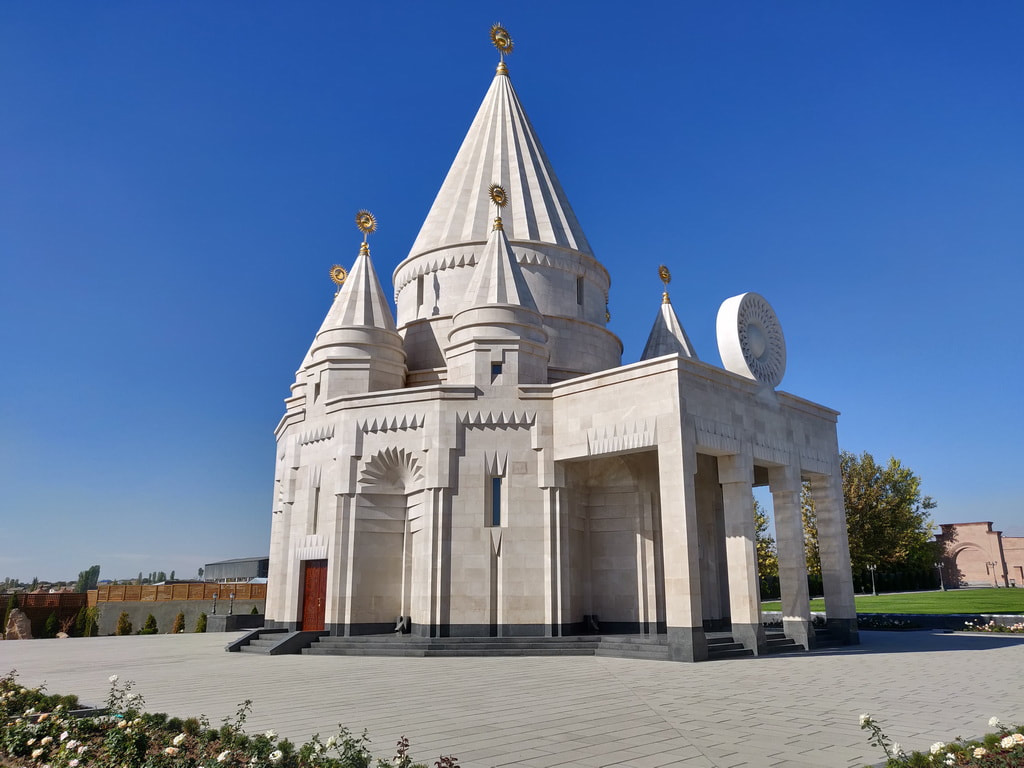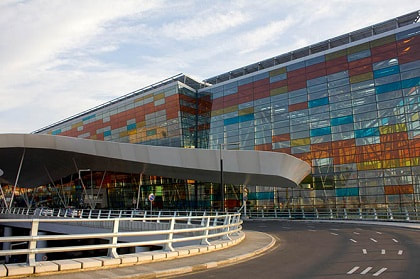-
Tour program
-
Map of the tour
-
Notes and suggestions
-
Quotation request
<
>
Day 2. Yerevan city tourAfter breakfast, the tour of the city of Yerevan starts with Victory Park, which houses the statue to Mother Armenia, and from which you will be able to admire the best view of the city. Continue to the Cascade Complex, a monumental staircase that houses the modern art collection of Gerard Cafesjian. Continue for a walk in the city center, passing through the Square of the Armenian Opera House and Northern Avenue, the pedestrian shopping street, up to Republic Square, surrounded by the most beautiful buildings in the city, where the Stalinist style meets the Armenian architecture, and where the dancing fountain show takes place every evening in summer. Visit of the State Museum of Armenian History, one of the best museums of the former Soviet Union, which gives an in-depth insight into the culture and history of Armenia through the display of more than 400,000 objects covering a period starting from the 3rd - 2nd millennium BC until present day. Stop at the Blue Mosque, the center of worship of the small Shiite Muslim minority, built during the reign of the Khans of Armenia, when ancient Erivan was its capital. A Shiite Mosque, it was renovated with funds from Iran and today, of the eight historical mosques in Yerevan, it is the only one left standing after the Soviet rule of Armenia, thanks to the fact that it was transformed into the museum of Yerevan. Stop at the GUM, the spice and dried fruit market, a unique opportunity to discover the everyday life of the Armenians. Overnight in Yerevan.
|
Day 3. YEREVaN - Khor Virap - Areni - Noravank - Qarahunj - GorisAfter breakfast, departure to the south of Armenia and visit the monastery of Khor Virap, dominated by the snow-covered profile of the magnificent Mount Ararat, in an evocative position near the border with Turkey. The fortified monastic complex houses inside the well-prison (Khor Virap means "deep well") in which in the third century St. Gregory the Illuminator was imprisoned for thirteen years. Departure for the region of Vayots Dzor, characterized by views of jagged rocks, and visit of the site of Areni-1, a cave where there is evidence of the oldest winemaking tradition in the world (dating back to about 6000 years ago). In this place, archaeologists found all the tools necessary for the production of wine which, according to the findings, was somehow connected to the cult of the dead. Stop for a tasting of wines produced from native grapes in a local winery and continuation to Noravank, the masterpiece of the architect Momik, a monastery surrounded by rugged gray and red rocky mountains, with the two-storey church, unique throughout Armenia, dedicated to Surp Astvatsatsin, richly decorated with bas-reliefs. After passing the Vorotan pass at 2200 m a.s.l., the landscape extends to the southern Armenian plateau, with landscapes that in spring are entirely covered with carpets of multicolored flowers. Stop along the road at Qarahunj, the "Stonehenge of Armenia", a site dating back to the Bronze Age made up of 204 megaliths scattered with tombs dating back to 3,000 BC. Arrival in Goris and overnight.
|
Day 4. Goris - Khndzoresk - Tatev - Aghitu - Vorotnavank - YeghegnadzorAfter breakfast, departure to Khndzoresk, the remains of a troglodyte village abandoned in the 1950s with houses and stables excavated from the 5th century on the slopes of a hill east of Goris. The journey continues west to visit the Tatev Monastery, which will be reached from Halidzor with “The Wings of Tatev”, the longest cable car in the world (5.7 km 11 minutes journey). The monastery is of fundamental importance for the knowledge of Armenian medieval art and culture, it was the seat of a famous university and is situated in a spectacular position on a spur of rock overlooking the valley of the Vorotan river. Departure for the village of Aghitu, where, in the small cemetery, there is a double-arched funeral monument dating back to the 6th - 7th century probably dedicated to the martyrs of the Christian religion. Continuation towards the village of Vorotan to visit the Vorotnavank Monastery. The Monastery, which includes two churches, a gavit and numerous ancillary environments, stands out among bare hills covered with grass and flowers on the edge of the Vorotan river valley. Arrival in Yeghegnadzor and overnight.
|
Day 5. Yeghegnadzor - Selim - Noratus - Sevan - DILIJANAfter breakfast, departure for the north of Armenia with a stop at the Selim pass to visit the Orbelian caravanserai, a three-nave basalt block structure used by the caravans that traveled the ancient Silk Road. Continuation to Noratus, a village located on the shores of Lake Sevan, famous for its monumental cemetery, full of khatchkars dating back to a period ranging from the 9th to the 17th century. Time for a tasting of local cheeses in a cheese factory in the village, some of which matured in wine or cognac. The journey continues along the southern shore of Lake Sevan, the "Emerald of Armenia", one of the highest freshwater alpine lakes in the world that alone occupies one-thirtieth of the entire surface of Armenia. Visit the Sevan peninsula, on which the Sevanavank Monastery stands, from which spectacular views of the surrounding mountains open up. Arrival in Dilijan, a town located in the center of the National Park of the same name, in an area full of woods and waterways, nicknamed "the Switzerland of Armenia" for the splendid natural landscapes that surround it. Time available for a walk in the old part of Dilijan where there are some small shops of local artisans. Overnight in Dilijan.
|
Day 6. Dilijan - Molokan Villages - Akhtala - HaghpatAfter breakfast, departure for the villages of the Molokan minority. These people, of Russian origin, practice a unique form of the Christian Orthodox religion, which was declared heresy at the end of the nineteenth century and for this reason the Molokans were sent into exile on the borders of the empire. Many of them settled in Armenia and nowadays they still live their lives in the same way they lived over a century ago. Meeting with one of the families to taste the tea made from Samovar and homemade desserts. Continue to the Debed River Valley to discover the jewels of medieval architecture that this place hosts. The first visit is the fortified church of Akhtala, one of the few churches in Armenia with walls covered with paintings which were executed between 1205 and 1216 and which today represent one of the finest examples of Byzantine art outside the Empire of Byzantium. Continuation to Haghpat Monastery, built in the 10th century and protected by UNESCO, considered one of the highest examples of medieval Armenian religious architecture. In the 12th century the monastery was among the most important in Armenia and became one of the main centers of Armenian culture. Sayat-Nova, the most famous Armenian bard and singer, lived in Haghpat for twenty years. Overnight in Haghpat.
|
Day 7. Haghpat - Sanahin - Marmashen - GyumriAfter breakfast, departure for Sanahin, the second UNESCO protected monastery of the Debed Valley, famous for its three-nave gavit, unique in all of Armenia, for the presence of an Academy where the Medieval Liberal Arts were taught, and for its scriptorium. Continuation to Gyumri, the second largest city in Armenia, located a short distance from the border with Turkey. Visit of the city, whose center revolves around Vardanants Square, overlooked by the Town Hall, the church of Yot Verk, which houses a venerated icon of the Holy Virgin with the seven wounds, and the church of the Holy Savior, today under reconstruction after the collapse which occurred following the devastating earthquake of 1988. In the square also converge the streets with the typical buildings of the old city, formerly known as Kumayri, characterized by beautiful black tuff architecture in Neoclassical and Art Nouveu Style dating back to the end of the nineteenth century. The city is dominated by the black fortress, Sev Berd in Armenian, built in the second half of the nineteenth century to defend the city. Continuation to Marmashen monastery, located on the bank of the Akhurian river, characterized by its beautiful churches of an enchanting apricot-colored tuff built next to each other near an orchard. The style of the monastery follows the style of the Bagratid capital Ani, today in Turkish territory. Overnight in Gyumri.
|
Day 8. Gyumri - Yereruyk - Dashtadem - Amberd - Saghmosavank - YerevanAfter breakfast, departure for Yereruyk, the first Christian basilica in the territory of Armenia, dating back to the IV-V century and built in the style of the Syriac Christian basilicas, located right next to the gorge of the Akhurian river which marks the border between Armenia and Turkey. Continuation towards south, along the border with Turkey up to Dashtadem to visit the remains of the ancient fortress dating back to the 10th century surrounded by an octagonal wall dating back to the 19th century. On the east wall of the fortress there is an Arabic dedicatory inscription from 1174, written in Kufic script that attributes the structure to Sultan ibn Mahmud (Shahanshah), one of the Shaddadid princes who reigned in Ani. Ascent to Amberd, a 7th century fortress located on the slopes of Mount Aragats at about 2300m above sea level, which was attacked several times over the centuries but which only Tamerlane's army managed to conquer. Visit of Saghmosavank, the monastery of the Psalms, built in the 13th century on the edge of the deep gorge of the Kasagh River. Arrival in Yerevan and overnight.
|
Day 9. Yerevan - Echmiadzin - Aknalich - Zvartnots - YerevanAfter breakfast, departure to Echmiadzin, nicknamed the “Armenian Vatican” because it is the seat of the “Catholicos”, the head of the Armenian Apostolic Church. Visit of the Mayr Ator Cathedral, the oldest Christian cathedral in the world, declared a UNESCO World Heritage Site. Visit of the church of Saint Gayane, built in 630 on the burial place of the Roman abbess who was martyred with other virgins (including Hripsime) in the 4th century by order of the Armenian king Tiridates II. The current architectural form, despite partial restorations to the dome and ceiling made in the seventeenth century, maintains the appearance of the original building. Visit of the church of Saint Hripsime, built in 618 on the tomb of the holy martyr, which represents the most admirable example of a domed tetraconch church in all of Armenia. Both churches were inscribed in the list of UNESCO World Heritage sites in 2000. Continuation to Aknalich, a village populated by the Yazidi minority of Armenia, to visit the temple dedicated to Melek Tawous, the Peacock God. Return to Yerevan and, along the way, stop at the Zvartnots Cathedral (UNESCO World Heritage Site), built in the 7th century and destroyed in the 10th century by an earthquake, famous for the very fine bas-reliefs that combined Christian symbols with pre-Christian symbols and built on an earlier site from the urartic era. Optional visit to the Ararat distillery for a tasting of the famous Armenian cognac said to be a favorite of Sir Winston Churchill. Overnight in Yerevan.
|
- The interior of the Echmiadzin Cathedral is currently closed for restoration works. For this reason, until the end of the works, the visit foreseen by the program will be carried out only from the outside.
- The road that crosses the Debed Valley and leads to the Haghpat and Akhtala monasteries is undergoing renovation and the works will continue until 2021. A spirit of adaptation is necessary due to the harsh road conditions and the inevitable slowdowns that they entail . However, scheduled visits will proceed as normal.
- The trip is suitable for everyone and does not present any particular difficulties, although on some days the program is full of visitors. Short walks are planned to reach the places of visit from the point where the means of transport must stop. People with reduced mobility should be aware that unfortunately there are no devices in the country that allow them to overcome stairs and unevenness and, furthermore, within the sites, the sidewalks are usually uneven and the roads are not paved.
- It is advisable to wear comfortable shoes and clothing that take into account variations in temperature, especially in regions outside of Yerevan, even in summer.
- All museums and the Tatev cable car are closed on Mondays.
- The Vernissage Market is open daily, but can be visited at its fullest only on Saturdays and Sundays.












